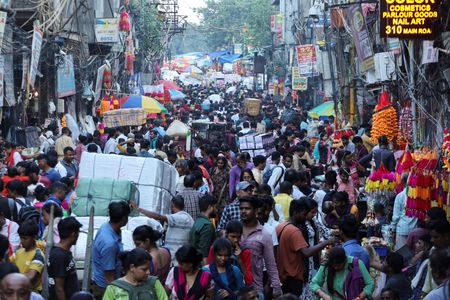By Vivek Mishra
BENGALURU (Reuters) – India’s economy will grow well below its potential over the next two years, with inflation staying above the mid-point of the Reserve Bank of India’s tolerance band despite recent interest rate rises, according to a Reuters poll of economists.
While growth was expected to be faster than many other economies, it would be too slow for the job creation needed to pull tens of millions of people out of poverty in a country typically ranked one of the worst in the world for hunger.
Growth likely slowed sharply to an annual 6.0% in the third quarter from 13.5% in the second that was supported mainly by statistical comparisons with a year earlier rather than new momentum. It was expected to decelerate further to 4.4% in the fourth quarter, according to an Oct. 13-19 Reuters poll.
The median expectation was for 6.9% growth in the 2022-23 fiscal year, slightly above International Monetary Fund (IMF) and World Bank projections of 6.8%. It was forecast to slow to 6.1% next year.
While those figures were only trimmed from the previous poll medians, a deteriorating global economic outlook suggests there may be further downgrades in coming months.
“India has…its own set of domestic challenges: weak employment, negative real wages and weakening industrial activity even in the lead up to the main festive season,” noted Kunal Kundu, economist at Societe Generale.
“This, we believe, will result in the RBI having to shift its focus toward supporting growth and away from anchoring inflation expectations by engineering a growth slowdown.”
The poll results underscore how the RBI’s interest rate-hiking campaign, which only started five months ago and according to the poll will end in the first quarter of 2023, has done little to bring down price pressures.
Inflation is felt most acutely by lower-income households who form a significant portion of the country’s population of about 1.4 billion people.
Like other economies around the world, India has struggled with soaring energy prices stemming from Russia’s invasion of Ukraine and a particularly devastating pandemic, from which businesses are still recovering.
India’s retail inflation accelerated in September to a five-month high of 7.41% year-on-year as food prices surged, raising fears of further rate hikes when the central bank meets for its next policy review in December.
While the central bank’s targeted band for inflation is 2%-6%, the poll showed inflation would average 6.7% in the year ending March 2023, and 5.2% in the following year, a small upgrade from 6.6% and 5.0% in a September poll.
“Easing food and energy inflation will drag headline consumer price inflation lower over the coming months, but strong underlying price pressures mean that the drop will be gradual and inflation will remain elevated,” noted Shilan Shah, senior India economist at Capital Economics.
A falling rupee, which has lost over 10% of its value against the dollar this year, is also adding to inflationary pressures through import prices.
Despite the RBI burning through its dollar reserves, the rupee has hit multiple lifetime lows against the greenback this year and was trading close to 83 per dollar on Wednesday.
The poll showed the RBI taking a softer approach with rates. Despite no clear majority, median forecasts showed the central bank hiking the repo rate by another 50 basis points to 6.40% by end-March. It was then expected to stay there until end-2023.
(For other stories from the Reuters global long-term economic outlook polls package:)
(Reporting by Vivek Mishra; Polling and analysis by Devayani Sathyan and Veronica Khongwir; Editing by Hari Kishan, Ross Finley and Bernadette Baum)

